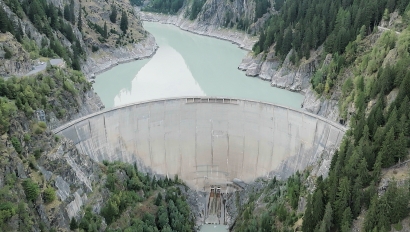
Hydropower, an often overlooked energy source, has a long history of generating green electricity and providing grid services to support energy systems worldwide. It also has a crucial role to play in the climate challenges that lie ahead.
In fact, doubled hydropower output worldwide by 2050 will be vital to keeping global temperature increases under 1.5ºC, according to the most recent International Energy Agency (IEA) projections.
Currently, hydropower is responsible for 60 percent of all clean electricity worldwide. With huge potential remaining for further development, hydropower is the only low-carbon technology that can provide flexible energy storage at scale to support the growth of wind and solar needed deliver net zero by 2050.
The benefits of hydropower
Hydropower’s constant supply is therefore a perfect green complement to the variability of wind and solar energy. Through pumped storage, which involves two interconnected reservoirs at different levels, hydropower can achieve energy storage efficiency of around 80 percent. In essence, it’s a giant natural battery.
Pumped storage hydropower facilities, common in high mountain ranges, use sophisticated technologies to deliver or receive the exact amount of electricity required by the grid. They offer high levels of precision and flexibility that now outperform fossil-fuel alternatives.
Another major advantage is that some hydropower facilities can readily incorporate other clean energy sources. For example, there are reservoirs in the Swiss Alps that are connected to a local solar plant. This guarantees high-volume production during peak demand times, and demonstrates to investors that different renewable methods can be combined for maximised output round the clock, whatever the prevailing weather conditions.
Low-cost electricity for generations to come
Hydropower plants are expensive to build, so considerable early investment is required to get them up and running. Once this is achieved, however, the payback can be massive over the following decades. In contrast to other renewable energy plants, hydropower facilities are low maintenance and have negligible operating costs.
It is also important to note that hydropower has the highest Energy Payback Ratio (EPR) of all electricity generation and storage technologies. The EPR is defined as the ratio of total energy produced during a system’s normal lifespan divided by the energy required to build, maintain and fuel it. A study by the Swiss Academy of Engineering Sciences shows that the EPR of a conventional hydropower plant is more than 20 times better than that of fossil power plants. With this mind, there can be little doubt that hydropower is not only more sustainable than carbon-intensive alternatives, but significantly more cost-effective too.
In addition, there are many existing redundant or underused hydropower facilities – particularly across continental Europe – that are ripe for improvement. Revamps and upgrades are typically straightforward and therefore attractive for potential investors. Among those given a new lease of life recently is a large 340 MW hydropower station in Wallis, Switzerland. Originally brought onstream 53 years ago, the Bitsch Power Station was a reliable power supplier for decades, before performance dipped because of ageing plant facilities and technology. A refurbishment that saw the installation of a pair of leading-edge generators has now extended its viable life until at least 2048.
Tackling the climate crisis
With climate catastrophes such as extreme droughts and floods becoming more common, effective conservation, control and maximised use of water have never been more important.
The reason that arid, hot regions, such as the Iberian peninsula, can mitigate the impacts of today’s droughts is that they committed heavily to water systems during the 1970s. They can responsibly and reliably manage their water because of the presence of hydropower reservoirs commissioned up to 50 years ago. These are vital in preventing floods, capturing and maximising rainfall to combat drought, and for the efficient irrigation of farmland and wild areas.
It’s no coincidence that the regions with energy supplies that have the best resistance to extreme climate incidents are those that have invested in improving and evolving their hydropower facilities. However, greater international cooperation is required. Improved concord and connectivity between regions that may be hit by different climate impacts is only possible with the best hydropower transmission technologies, networks and grids.
Ensuring sustainable hydropower supply
Of course, hydropower can only contribute positively to the fight against climate change if hydropower facilities are, in themselves, sustainable. That’s why last year, a universal quality standardisation was introduced to the hydropower industry.
Devised and designed through a multi-stakeholder process, the Hydropower Sustainability Standard certification programme gives responsible hydroelectricity providers the chance to compare their performance against measurable international thresholds of best practice. They can then promote the performance efficiencies of their power stations and linked operations.
Hydropower’s future
The success of the energy transition is dependent on hydropower and there are encouraging signs that it is being taken seriously. China, for example, is taking a lead by placing hydropower development at the heart of its long-term strategies to reduce carbon emissions.
Governments, investors, energy companies and the general public must rally behind sustainable hydropower to place it firmly on the energy transition agenda. This is why we worked with key partners worldwide to launch the first ever Global Hydropower Day in October 2022.
Learn more here.

